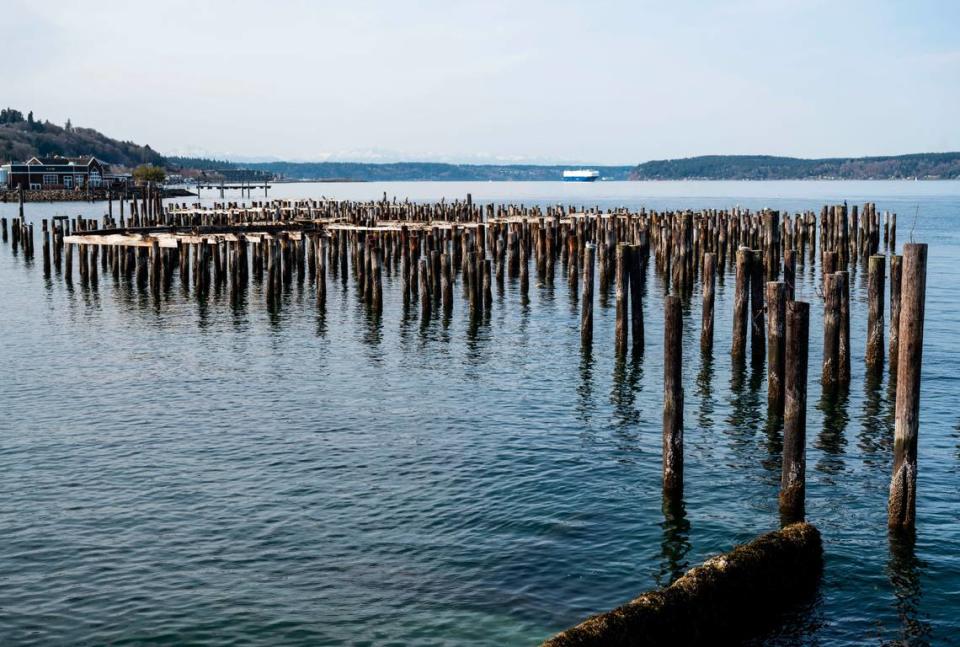Imagine going on a vacation to Brazil and then coming home to find your house missing. That’s what a colony of purple martins might face next year when the birds return to Tacoma after a long flight from South America.
Hopefully, they’ll quickly discover their nesting boxes have been moved 500 feet away.
The relocation by staff from the state Department of Natural Resources, Point Defiance Zoo & Aquarium, Northwest Trek Wildlife Park and Communities for a Healthy Bay earlier this month was necessitated by the then impending removal of 1,200 pilings just offshore from Tacoma’s Dickman Mill Park.

A male purple martin flies at Dickman Mill Park in this file photo. Zach Hawn/Point Defiance Zoo & Aquarium
The birds’ boxes were attached to some of those pilings which last week began disappearing from Puget Sound waters.
The blue birds (their feathers can have a purple sheen in the right light) spend their summers in nesting boxes at Dickman Mill, Titlow Beach and Chambers Bay, according to zoo conservation coordinator Zach Hawn. Tacoma is home to an estimated 16 percent of the state’s 600 purple-martin population.
The birds, North America’s largest swallow, spend spring and summer in Washington and the rest of the year in Brazil — a 4,000-6,000 mile journey. While here, they gobble insects and charm human admirers with their antics and bird songs.
“They sound like sci-fi lasers and clicks and very metallic sounding,” Hawn said. “They are also just really tenacious … how they can fight off a starling or house sparrow and kind of defend their nest box.”
Piling removal
The pilings that once supported the Dickman Mill are soaked in creosote, a wood preservative linked to cancer. The site is one of DNR’s “Filthy Four,” where funding approved by the state Legislature in 2023 is allowing their removal. With those pilings go the birds’ home.
But not for long.
All of the 18 houses and a few more will be reinstalled on poles in a marshy area just to the southeast of their previous location. It’s close enough to where the purple martins should easily locate them, Hawn said. Bird watchers and passersby will be able to get a close look from the pier that leads to the concrete remains of the mill.

Nearly 1,200 polluted creosote pilings remain in the water after being abandoned for decades since Dickman Mill, one of Tacoma’s pioneer sawmills, placed them there in the 1890s. Cheyenne Boone/Cheyenne Boone/The News Tribune
Bird watcher
Hawn, 32, has been a bird watcher since he was 15. Now, he manages a community-monitoring program where volunteers collect data about local purple martins, including their behavior.
The first birds that arrive, called scouts, loudly sing to alert their fellow martins where to land.
The birds need human intervention to succeed, according to the state Department of Fish and Wildlife, which lists purple martins as a species of greatest conservation need.

Female and male purple martins outside nesting boxes at Titlow Park in Tacoma. Zach Hawn/Point Defiance Zoo & Aquarium
Decline
Purple martin numbers began declining in the Pacific Northwest in the 1930s. That’s when logging removed enough of the large trees that provided cavities the birds used for nesting, according to Metro Parks Tacoma. Non-native birds like house sparrows and starlings competed with purple martins for resources and nests.
Purple martins nest as a colony, and human-made boxes help maintain their numbers, according to Metro Parks. The birds like to nest together without getting too close to each other. Otherwise, their bickering can become the, “soap opera of the Sound,” according to Hawn.
“For me, (they are) just an iconic part of the soundscape and the view of Pacific Northwest waterfronts,” he said.

Purple martins outside their nesting boxes at Dickman Mill Park. The boxes were recently removed before pilings were pulled from the water. The birds are at their wintering grounds in Brazil. Zach Hawn/Point Defiance Zoo & Aquarium
